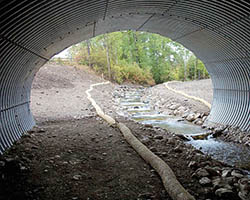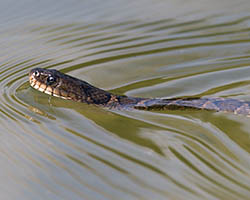
Why Did the Turtle Cross the Road?
What's in the Story?

You stand on the edge of the busy road. A car rushes by, pushing wind into your face. You look left, then right, then left again, waiting until the road is clear. When it's finally safe to cross, you step off the sidewalk and quickly work your way across the road. Unlike you, animals don’t know how to cross roads safely, and as a result many animals are hit by cars.
People have started building “ecopassages”, which are tunnels that go under roads or bridges that go over them. Will animals use them to cross safely? In the PLOS ONE article, “Mitigating Reptile Road Mortality: Fence Failures Compromise Ecopassage Effectiveness,” researchers learned that most reptiles will not use ecopassages if there is another way to cross the road.
Danger on the Highway
He took a step and paused. He took four more and paused again. At this rate, he'd take 20 minutes just to cross the road. Turtles are often slow, and this can make it dangerous for them to cross roads. In fact, crossing roads is dangerous for all reptiles. If we can keep them off of roads, we can save many of their lives.

One study in Florida tracked 343 turtles that tried to cross a four lane highway. Not a single one survived. People who build roads are trying to help by creating ecopassages so that animals can cross safely. Builders also put up fences or walls to keep animals off of roads and funnel them toward the ecopassages. But researchers wanted to know if animals will actually use these special pathways.
The researchers spent two years studying a highway in Ontario, Canada. This highway is near Lake Huron and is home to many reptile species. A portion of the highway was widened from two to four lanes. As part of that work, the builders installed an ecopassage that went under the road. Knowing this work was scheduled, the researchers conducted their study before the road was widened, and again afterwards. They studied the area where the passage was installed and an unchanged area, which acted as a control for the study.
The researchers used four different methods to look at the effect of the road and ecopassage on local reptiles. They radio tracked animals, directly tested whether turtles would use the ecopassage, photographed animals, and surveyed of animals on the roads.
Reptiles on the Radio

The researchers attached radio transmitters to 22 turtles (Blanding’s and snapping turtles) to keep track of where they traveled. Animals generally have a home range. If using the ecopassage would require a turtle to go outside its home range, scientists wanted to know if the turtle would use it to cross the road.
Only three of the turtles with radio transmitters crossed the highway over the study period. These adventurous turtles used a passageway that was built to drain water, rather than the ecopassage.
Let’s Take a Walk
The researchers also wanted to know whether reptiles were willing to use an ecopassage that was right in front of them. Of course it would have been easier if they could just have a conversation with their subjects (“hey little fella, just wondering if you knew about the fancy new tunnel under the road!”). Instead, the researchers had to come up with a clever way to test this.

They picked painted turtles because they know how to use the sun to find their home wetland. Each turtle was put in a cage on the opposite side of the highway from the turtle’s home. They were allowed to sit in the sun for 10 minutes so that it would know which way to go.
Scientists used a remote control to open the cage and watched where the turtles went. Only 5 out of the 69 turtles in this experiment walked through the ecopassage.
Strike a Pose
The researchers also installed cameras in the ecopassage and took pictures at regular intervals at night and whenever a motion sensor was triggered. The researchers have pictures of 485 individual animals using the ecopassage, including a lot of ducks and geese, but only 10 were reptiles.
Road Scholars

The researchers chose two sections for this experiment: the part where the highway was widened, and another section that was not. Each day, the researchers looked for reptiles on the road, alive and dead. If the reptiles were alive, their locations were recorded and the researchers gave them a lift to the other side of the road. For the animals who had been killed by cars, the researchers recorded their locations and took them off the road. Sadly 83% of the turtles and 84% of the snakes they found were dead.
Don’t Fence Me In
The fences were not well constructed and didn’t cover enough territory, so it was easy for the reptiles to walk around them. Plus, the plastic fence ripped in many places, leaving gaps big enough for the animals to use. The researchers counted 115 gaps in just 3 kilometers (almost 2 miles).
Up to 30% of the fence was partially underwater in the spring when snow melted, so the reptiles could just swim over it. Even worse, the number of animals killed after the ecopassage was installed increased. The researchers think that once the animals were on the road, they might not have been able to find their way off of the road because of the fences.

So if these ecopassages didn't work, what alternatives are there? Concrete or steel walls would be more expensive to install, but they would probably more effective and would not require regular inspections and maintenance like plastic fences do. The highway builders had good intentions, and spent a lot of money, but did not get a good outcome.
The researchers think ecopassages do work, but it is important for highway builders to invest in good barriers so that animals can't find another way across the road.
One study estimates that 1 in 5 reptile species are threatened with extinction. If being a little more thoughtful when building our highways keeps reptiles safe, that seems like a great investment.
Want to get involved with research near you? Visit our budding biologist links to find ways to help out with citizen science.
Additional images via Wikimedia Commons. Open road by William Warby.
Bibliographic details:
- Article: Why Did the Turtle Cross the Road?
- Author(s): Sharyn Horowitz
- Publisher: Arizona State University School of Life Sciences Ask A Biologist
- Site name: ASU - Ask A Biologist
- Date published: 21 Apr, 2015
- Date accessed:
- Link: https://askabiologist.asu.edu/plosable/why-did-turtle-cross-road
APA Style
Sharyn Horowitz. (Tue, 04/21/2015 - 15:25). Why Did the Turtle Cross the Road?. ASU - Ask A Biologist. Retrieved from https://askabiologist.asu.edu/plosable/why-did-turtle-cross-road
Chicago Manual of Style
Sharyn Horowitz. "Why Did the Turtle Cross the Road?". ASU - Ask A Biologist. 21 Apr 2015. https://askabiologist.asu.edu/plosable/why-did-turtle-cross-road
Sharyn Horowitz. "Why Did the Turtle Cross the Road?". ASU - Ask A Biologist. 21 Apr 2015. ASU - Ask A Biologist, Web. https://askabiologist.asu.edu/plosable/why-did-turtle-cross-road
MLA 2017 Style

Be Part of
Ask A Biologist
By volunteering, or simply sending us feedback on the site. Scientists, teachers, writers, illustrators, and translators are all important to the program. If you are interested in helping with the website we have a Volunteers page to get the process started.
